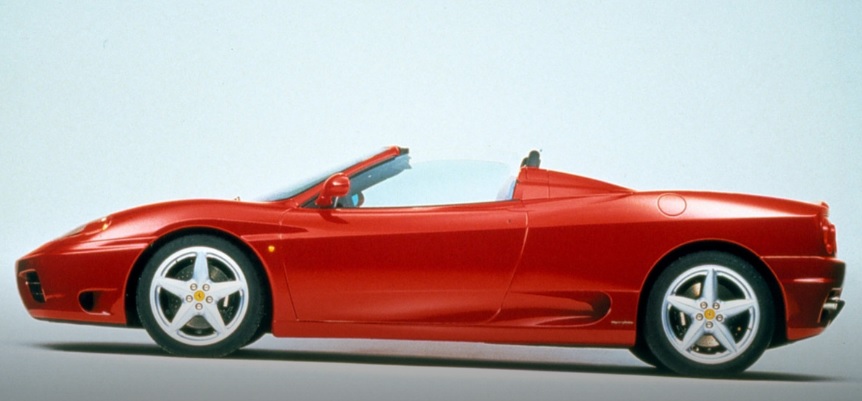

Convertible, 2 Doors, 2 Seats
17.9 l/100 km 13.14 US mpg
28 l/100 km 8.4 US mpg
12 l/100 km 19.6 US mpg
400 Hp @ 8500 rpm.
111.5 Hp/l
290 km/h 180.2 mph
3586 cm3
218.83 cu. in.
8, V-engine
Rear wheel drive,
4477 mm
176.26 in.
1922 mm
75.67 in.
1460 kg
3218.75 lbs.
| Brand | Ferrari |
|---|---|
| Model | 360 (Convertible) |
| Version | 360 Modena Spider |
| Engine version | 360 Spider (400 Hp) |
| Year production start | 1999 |
| Year production end | 2004 |
| Vehicle type | Convertible |
| Horsepower RPM | 400 Hp @ 8500 rpm. |
| Acceleration 0 - 100 kmh sec | 4.6 sec |
| Curb weight kg -lbs total |
1460 kg3218.75 lbs. |
| Overall length mm - inch |
4477 mm176.26 in. |
| Doors | 2 |
| Top Speed | 290 km/h 180.2 mph |
| Designation model | F131B |
|---|---|
| Engine position and orientation | Middle, Transverse |
| Cylinders | 8 |
| Position of cylinders | V-engine |
| Displacement (liters) |
3586 cm3218.83 cu. in. |
| Eng. horsepower RPM | 400 Hp @ 8500 rpm. |
| Horsepower per litre | 111.5 Hp/l |
| Weight / horsepower kg/hp - hp/tons |
3.7 kg/Hp274 Hp/tonne |
| Weight / torque kg/Nm - Nm/tons | 3.9 kg/Nm, 255.5 Nm/tonne
3.9 kg/Nm255.5 Nm/tonne |
| Torque Nm RPM lb-ft RPM |
373 Nm @ 4750 rpm.275.11 lb.-ft. @ 4750 rpm. |
| Bore (mm in) |
85 mm3.35 in. |
| Stroke (mm in) |
79 mm3.11 in. |
| Compression ratio | 11 |
| Fuel delivery system | Multi-point indirect injection |
| Fuel type | Petrol (Gasoline) |
| Valvetrain | 5 |
| Engine aspiration | Naturally aspirated engine |
| Engine oil liters | quarts |
9.95 l10.51 US qt | 8.75 UK qt |
| Engine coolant |
11 l11.62 US qt | 9.68 UK qt |
| Powertrain architecture | Internal Combustion engine |
| Engine location | Middle, Transverse |
| Drive configuration | Rear wheel drive |
|---|---|
| Transmission | 6 |
| Front brakes | Ventilated discs |
|---|---|
| Rear brakes | Ventilated discs |
| Anti-lock brake system | ABS (Anti-lock braking system) |
| Front suspension | Double wishbone |
|---|---|
| Rear suspension | Double wishbone |
| Wheels size | 215/45 R18; 275/40 R18 |
|---|
| Passengers seats | 2 |
|---|---|
| Trunk space min liter | cu. Ft. |
220 l7.77 cu. ft. |
| Overall length mm - inch |
4477 mm176.26 in. |
|---|---|
| Overall width mm -inch |
1922 mm75.67 in. |
| Overall height mm -inch |
1214 mm47.8 in. |
| Wheelbase mm - inch |
2600 mm102.36 in. |
| Track width front mm - inch |
1660 mm65.35 in. |
| Track width rear mm - inch |
1617 mm63.66 in. |
| Curb weight kg -lbs total |
1460 kg3218.75 lbs. |
|---|---|
| Gross weight kg -lbs total |
1760 kg3880.14 lbs. |
| Capacities kg - lbs |
300 kg661.39 lbs. |
| Fuel tank liters | gallons |
95 l25.1 US gal | 20.9 UK gal |
| City l/100km - mpg |
28 l/100 km8.4 US mpg |
|---|---|
| Highway l/100 km - mpg |
12 l/100 km19.6 US mpg |
| Combined l/100 km - Mpg |
17.9 l/100 km13.14 US mpg |
| Autonomy km (combined use) | 559 |
8 CYLINDER V-Engine
https://www.thecarspec.net/components/engine/8-cylinders-v